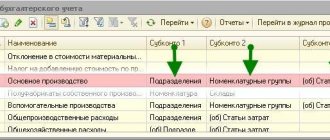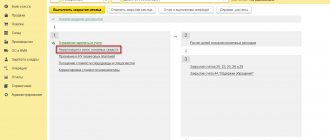It is generally accepted that a branch is a separate structural unit (the only one or one of several), a significant component of a legal entity (hereinafter also referred to as an organization). Clauses 2 and 3 art. 55 of the Civil Code of the Russian Federation states that such a unit must be located outside the location of the legal entity and can perform its functions in whole or in part, including representative offices. Data on such divisions of a legal entity are indicated in the Unified State Register of Legal Entities.
Typically, such branches include any territorial “branch” of a legal entity if stationary workplaces are equipped at its location. This means that they must be created for a period of more than a month. This is evidenced by the provisions of Art. 11 of the Tax Code of the Russian Federation. It should be taken into account that a separate branch is characterized by the following key features:
- carrying out specific activities on behalf of the parent organization, without being a legal entity;
- documenting internal movements carried out with the organization, as well as displaying mutual settlements in accounting;
- lack of its own, autonomous balance;
- allocation of property to the organization, the owner of which the branch for this reason still does not become;
- the possibility of an organization opening an account for him in order to finance current expenses;
- lack of opportunity to participate in the formation of the authorized capital (AC).
It is recognized that the movement of funds from account to account (between an organization and its branch) is precisely a transfer, but not income or expenses. The key internal document of such a division is the Branch Regulations. The information that should be displayed in it is decided by the parent organization. It is she who organizes tax and accounting in any branch created by her.
Important! The branch forms and maintains accounting depending on its membership in a particular type and in relation to the accounting policies determined by the parent organization.
He does not have the right to develop his own accounting policy (in relation to the norms of PBU 1/2008, approved by Order of the Ministry of Finance of the Russian Federation No. 106n dated October 6, 2008, as amended on April 28, 2017).
On the issue of organizing accounting in separate divisions of a legal entity
In general, the organization of accounting by the parent organization can take different forms. Their use is influenced by the location of the branch, its functions, and the types of activities performed. Also of no small importance are the volume of business operations of the branch, the nuances and sources of its financing, the features of goods flow, and other financial movements.
The type of unit is of dominant importance in this process. They distinguish: a branch that is assigned, allocated to a separate balance sheet, or, conversely, not assigned (i.e., not allocated). Each of these types has its own characteristic features and distinctive features in terms of accounting.
As for the accounting policy (AP), its formation falls entirely on the shoulders of the parent organization. The purpose of the UE is based on the following principles:
- The general working chart of accounts, as well as methods of accounting, are determined.
- The procedure for carrying out analytical accounting of property (legal entity) and cash in the branch, as well as the distribution of expenses between them, is fixed.
- Regulations are established for settlements (with all employees and third parties).
- Corresponding separate sub-accounts are allocated for the branch that is not included in the autonomous balance sheet.
- A system of mutual document flow (“legal entity – its division”) is being established.
- A clear procedure for accounting and documenting business transactions is being introduced.
- The forms of reporting used (tax, accounting, other) are approved.
Among other things, the accounting policy should determine the circle of specific responsible persons, as well as acceptable methods of delivering the required documentation to the organization from its unit.
Accounting in a branch included in the autonomous balance sheet
Unlike the previous type of division, in this case, when a branch is assigned to an autonomous balance sheet, its accounting is carried out separately from the accounting of the parent organization. What does the phrase “autonomous, separate” balance mean? As the Ministry of Finance of the Russian Federation notes (see letter No. 04-05-06/27 dated March 29, 2004), this concept is excluded from PBU No. 4/99.
Meanwhile, for the purposes of applying the norms of Ch. 30 of the Tax Code of the Russian Federation, it should be considered that this is a specific list of indicators that the organization has established for its branch. Taking them into account, the division forms its own autonomous balance sheet and reflects the actual property and financial position.
| Features of the operation of a branch included in the autonomous balance sheet | ||
| The branch has its own accounting service (with a staff member of the chief accountant), which conducts accounting and prepares reports independently from the parent structure | The working chart of accounts is formed in relation to the specifics of the branch's activities. As established, not used: sch. 80, 84, 75 and other accounts that are relevant and applied in the parent organization | The branch's accounting department deals with: compilation, systematization, processing, storage of primary documents; taking into account all business transactions, existing obligations and transferred property, which in one way or another relate to the activities of the organization |
Mutual settlements between a legal entity and its structural unit included in the autonomous balance sheet are displayed using an account. 79 (plus subaccounts 97-1 “Calculations for allocated property” or 79-2 “Calculations for current business operations” and other subaccounts). And so on for each branch.
The generated internal reporting is submitted by the division's accounting department to the head office. The received documentation is then used in the preparation of quarterly and annual reporting for the entire organization. As is customary, the count data is analyzed. 79, the balances of the DT of the organization’s subaccounts are compared with the CT of the branch’s subaccounts, and then the CT of the organization and the DT of its division. There shouldn't be any discrepancies.
After this, the “head” accounting department clears out the balances, but in accounting. does not conduct reporting. Accordingly, indicators on the activities of the branch for a specific reporting period are added to the relevant data for the organization. For your information, a similar scheme of actions is used when generating different forms of reporting. For example, when preparing a report on losses and profits or on the movement of funds.
| ★ Best-selling book “Accounting from scratch” for dummies (understand how to do accounting in 72 hours) > 8,000 books purchased |
Branch tax reporting
A branch is a separate division of a company that is located outside its location and carries out its functions. In turn, according to Article 11 of the Tax Code, a separate subdivision is understood as any territorially separate subdivision at the location of which stationary workplaces are equipped. In this case, a workplace is considered stationary if it is created for a period of more than one month.
Please note: a branch is not a legal entity. He only receives property from the company that created it and acts on the basis of the provisions approved by it.
Tax registration of the branch
So, a branch is a separate division of a company. True, there is some difference between these concepts. The branch must be indicated in the constituent documents of the company (Article 55 of the Civil Code). This requirement does not apply to a separate division.
Despite this, the company is required to register with the tax office at the location of each separate division (and therefore the branch). This is stated in paragraph 1 of Article 83 of the Tax Code.
Some managers are wondering, if only one workplace is organized outside the location of the organization, is it necessary to register for tax purposes in this case?
This problem follows from the content of paragraph 2 of Article 11 of the Tax Code. It says here that one of the conditions for recognition of a separate unit as such is the presence of equipped stationary workplaces. One gets the impression that if only one place is equipped, then there is no need to register.
Let us note that the courts were of the same opinion. For example, the arbitrators of the Federal Arbitration Court of the Moscow District (see resolution of October 3, 2001 No. KA-A40/5441-01) recognized the provisions of paragraph 2 of Article 11 of the Tax Code as “unclear”. Therefore, they supported the position of the company, which did not register for tax purposes at the location of a separate division where only one person worked.
However, as time passed, the judges' views changed. Now they believe that registration is mandatory even if only one workplace has been created in a separate division. For example, the arbitrators of the Federal Arbitration Court of the Moscow District came to this conclusion (see resolution of January 23, 2003 No. KA-A41/9052-02).
Let us note that the position of the tax authorities regarding the registration of a separate division remains unchanged. In their opinion, such an obligation does not depend on whether one or more workplaces are equipped (see letter of the Ministry of Taxation dated April 29, 2004 No. 09-3-02/1912).
Currently, the procedure for registering separate units is regulated by order of the Ministry of Taxes of March 3, 2004 No. BG-3-09/178. To register a branch, you need to submit an application to the inspectorate at its location in form No. 09-1-1. This form is given in Appendix 2 to the order of the Ministry of Taxes. This must be done within a month (clause 4 of Article 83 of the Tax Code) from the moment when workplaces are equipped in the branch and it begins its activities.
How to calculate taxes
The branch is not a tax payer, unlike the parent company. He can only fulfill the duties of his parent company in paying certain taxes. And in such cases, the branch must submit tax returns to the tax office at its location.
income tax
The total amount of income tax for the entire company, together with its branches, is paid by the parent company itself (Article 288 of the Tax Code). At the same time, it does not distribute the amounts payable to the federal budget and pays in a single payment. And the tax attributable to regional and local budgets is transferred separately to the place of its registration and to the place of registration of the branch.
In accordance with paragraph 1.5 of the Instructions for filling out an income tax return (approved by order of the Ministry of Taxes and Taxes dated December 29, 2001 No. BG-3-02/585), at the place of registration of the branch, you must submit a declaration consisting of:
– title page;
– subsection 1.1 and (or) subsection 1.2 of Section 1;
– appendix 5a to sheet 02 with the amount of tax that is paid at the location of the branch.
The declaration must be submitted to the tax authorities no later than 28 days from the end of the reporting period, that is, no later than July 28.
Property tax
If a branch is allocated to a separate balance sheet and has taxable property, then the parent company must pay tax for it at the location of the branch (Article 384 of the Tax Code).
In this case, a calculation of advance payments should be submitted to the tax office at the location of the branch, consisting of:
– title page;
– section 1;
– section 2;
– section 4 with the value of the taxable property of the branch and the amount of tax for the branch;
– Section 5 if the branch has tax-free property.
The branch must submit calculations for advance payments for the first half of 2004 no later than July 30.
VAT
The parent company must pay VAT and report on it. She pays the entire amount of tax without breakdown by division according to the details of her tax office (clause 2 of Article 174 of the Tax Code).
The company must also submit a consolidated declaration at the place of its registration (clause 5 of Article 174 of the Tax Code). The company is not required to submit reports to branch inspection offices.
UST
If a branch is allocated to a separate balance sheet, has its own current account and pays salaries to employees, then it fulfills the obligation to pay the Unified Tax for its parent company (clause 8 of Article 243 of the Tax Code). In all other cases, the UST for the branch must be paid by the parent company.
A branch that independently pays the Unified Tax must report this tax to the tax office at its place of registration. When calculating advance payments under the UST, he must indicate only his own tax amount. The parent company also fills out the calculation only for its accruals, but at the same time it additionally fills out the section where it indicates the Unified Tax for each branch.
Please note: regardless of how the company pays the UST, it must calculate the conditions for the right to apply regressive rates to the organization as a whole.
Calculations for advance payments under the UST must be submitted no later than July 20, 2004.
A similar reporting procedure is provided for contributions for compulsory insurance against accidents and occupational diseases.
Contributions to the Pension Fund
The procedure for paying pension contributions is established in the Law of December 15, 2001 No. 167-FZ “On Compulsory Pension Insurance in the Russian Federation”. According to it, the parent company must transfer contributions to the location of the branch from its current account, even if the branch has a balance, account and pays salaries to employees. This is inconvenient, since the unified social tax in such situations is paid by the branch itself. Officials met the companies halfway and issued a joint letter from the Ministry of Taxes and the Pension Fund of June 11 and 14, 2002 No. BG-6-05/835. In it, they allowed branches that themselves pay UST to independently transfer insurance contributions to the Pension Fund.
Reporting on contributions is presented in the same way as reporting on the Unified Social Tax. If a branch pays contributions, then it submits calculations for advance payments only on its own amounts, and the parent company - only on the amounts that it pays. At the same time, the parent company presents the calculation of pension contributions for the organization as a whole and broken down by branches.
Calculations for advance payments of insurance premiums for compulsory pension insurance must be submitted no later than July 20, 2004
AG "RADA"
Accounting in a separate branch, not included in a separate balance sheet
A structural unit that is not included in the autonomous balance sheet has a small number of employees. The volume of business transactions carried out by him is also insignificant. Accordingly, there is no need to open a bank account for him. For this reason, accounting, and indeed tax accounting too, is carried out for it by the parent organization that created it.
| Some nuances of the operation of a branch not included in the autonomous balance sheet | ||
| Material, monetary, and other resources come to him from the parent organization | Primary documentation generated by the branch on behalf of and in the name of the parent organization is sent within the established time frame to its accounting department, which then processes them and accepts them for accounting. | Separate sub-accounts for the branch (in order to reflect the accounting of property and existing liabilities) are created by the organization. It is on them that households take into account. operations of a separate branch |
A branch that is not included in the autonomous balance sheet can independently conduct accounting and tax accounting, provided that its staff provides an accountant rate . Then he deals with “accounting” issues, but again exclusively in the order established by the accounting policy of the organization. It should be recalled that it is formed only by the parent organization, and the branch does not participate in this process. Most often, such “independent” accounting of a department is limited only to the processing and systematization of primary documentation.
All certificates and registers prepared by the branch accountant are sent to the organization in finished form. Based on this received documentation, it displays business transactions on its accounting accounts.
Income tax, property, transport
Separate divisions, the accounting and reporting of which are stipulated by the accounting policy, do not submit income tax returns. But the parent organization is obliged to pay part of the tax to the regional budget at the location of its separate entity and report on the breakdown of its remote structures.
Balance sheet divisions may own objects on which property tax is charged. Tax amounts should be paid and reported to the tax office of the OP. The transport tax declaration is submitted at the place of registration of the unit if the vehicles are located on its territory.
Example 2. Cash flow between an organization and a branch included in the autonomous balance sheet
So, all payments between the branch and the organization are made using an account. 79. When recording transactions, the branch must show: receipt of deducted money, transferring it to such and such an account, the fact of salary transfer, its own revenue, settlements with the supplier.
| Basic transactions for the branch | ||||
| receiving money from the account of the parent organization | deduction of money by the branch for settlement. your organization's account | deduction of salaries to branch employees | transfer of money from the organization’s account to the supplier under an agreement concluded with its branch | branch revenue per race. organization account |
| DT 50 KT 79 | DT 79 CT 50 | DT 70 – KT 79 | DT 60 KT 79 | DT 79 KT 62 |
In turn, the parent organization displays essentially the same operations within the framework of this movement of funds. They relate to the receipt of money by its branch, the transfer of money to their own account, the transfer of salaries to the accounts of employees of a structural unit, etc. The postings also use an account. 79. When making such calculations, it is important to reconcile the calculations between the organization and its branch.
Reports on personal income tax and insurance premiums
So, there is a separate division - where to submit reports? Personal income tax is paid at the location of the head enterprise and structural unit. Reports are submitted using the same principle.
When delegating to a branch structure the right to calculate and pay salaries to its employees, the division becomes obligated to pay insurance premiums and subsequently submit reports on them. That is, a separate division pays and reports at its location.
If the salary of branch employees is calculated by the organization itself, then contributions with reports will go to the place of registration of the parent enterprise.
Common mistakes of a legal entity and its separate branches
Error 1. If an organization has created at least one separate branch, then it does not have the right to apply the simplified tax system. This norm follows from paragraphs. 1 clause 3 art. 346.12 Tax Code of the Russian Federation.
In this regard, the Ministry of Finance of the Russian Federation (letter No. 03-11-11/29010 dated April 22, 2020) draws attention to the fact that if an organization has applied the simplified tax system previously, then in order to continue to apply this tax regime, it must comply with all the conditions outlined in Chapter. 26.2 Tax Code of the Russian Federation.
Deputy Director of the Department R. A. Sahakyan.
In addition, it should be noted that this Sec. 26.2 of the Tax Code of the Russian Federation covers in detail issues related to the use of the simplified tax system. Art. mentioned above. 346.12 contains an exhaustive list of persons who generally do not have the right to use the simplified tax system.
Reporting procedure
If a separate division does not have a separate balance sheet, then accounting is fully carried out by the parent company. This follows from the fact that this issue is not regulated separately by the legislation of the Russian Federation. In addition, it should be taken into account that activities related to accounting reports within the organization are not subject to transfer to the tax authority. This is due to the fact that all such documents are internal and the Tax Code of the Russian Federation does not oblige company divisions to maintain accounting reports and submit them to the tax authority (






